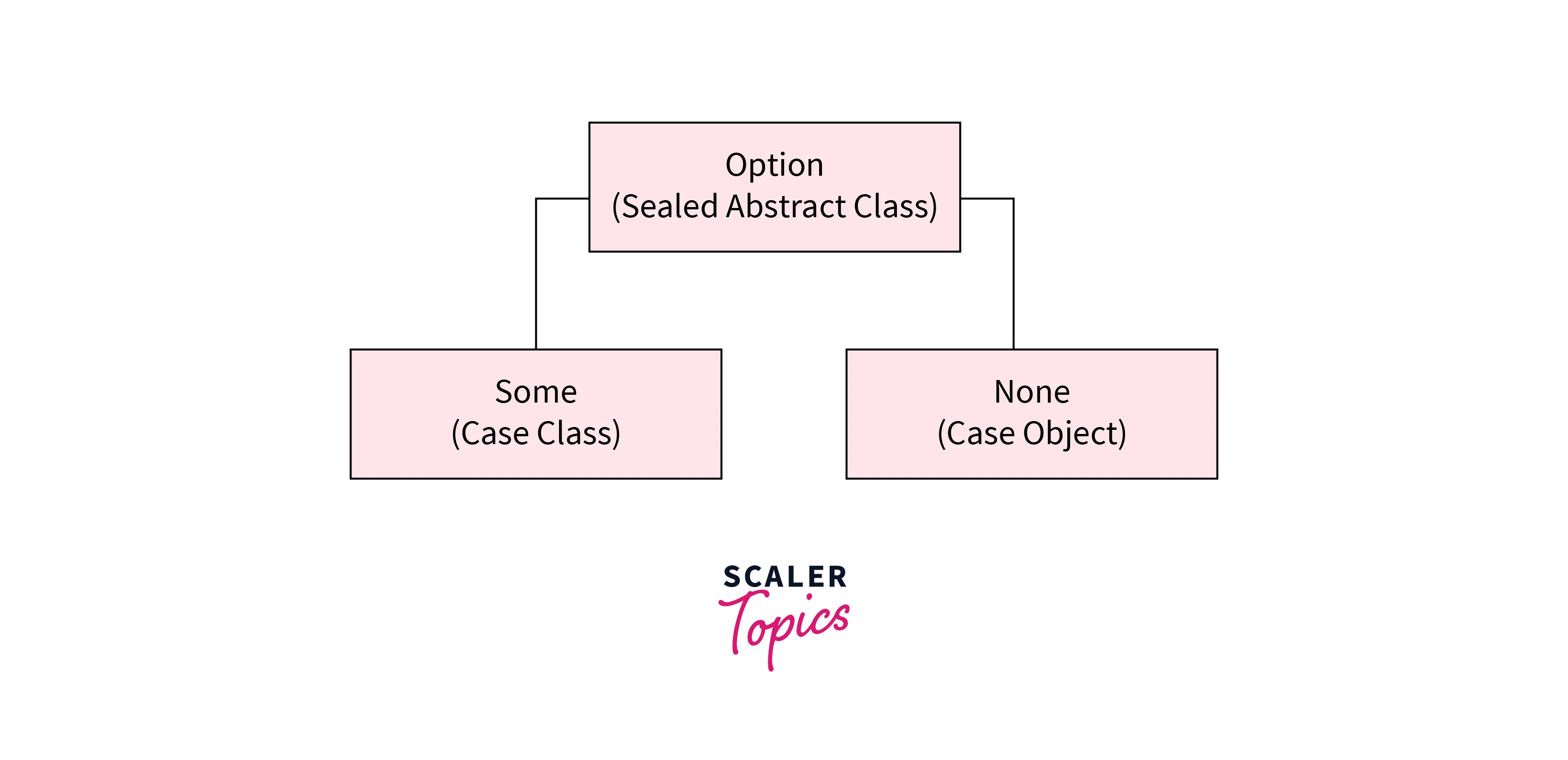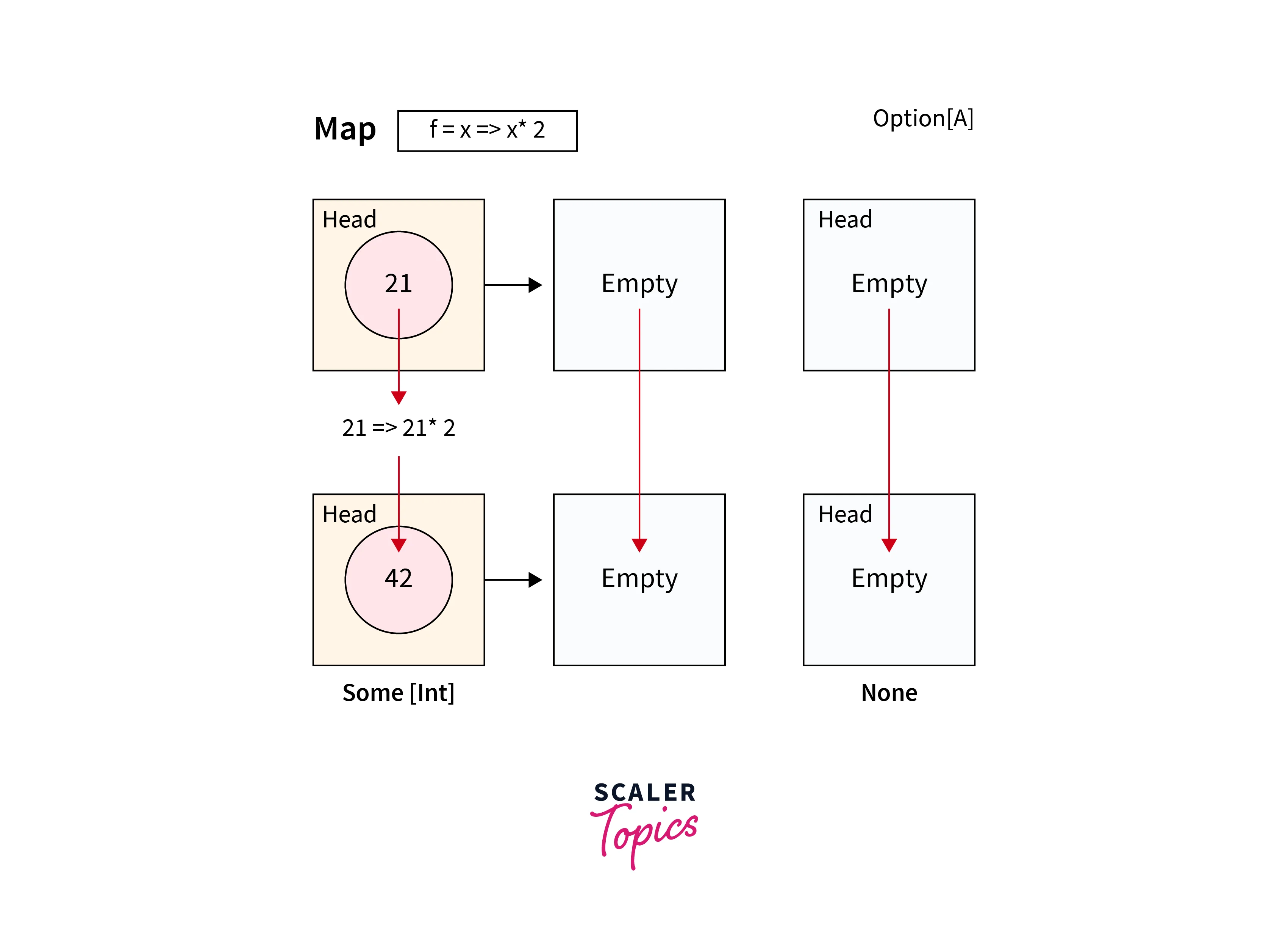Scala Options
Overview
Scala options are a fundamental concept in the Scala programming language for handling optional values. An option represents a value that can either be present (wrapped in a "Some" container) or absent (represented by "None"). This approach mitigates null reference-related issues, promoting safer and more readable code. We can employ methods like pattern matching, map, and getOrElse to manipulate option values without risking null pointer exceptions, resulting in more reliable and elegant code that explicitly accounts for the potential presence or absence of values.
Introduction
In the realm of programming, dealing with absent or optional values is a common challenge. Languages like Scala provide elegant solutions to this problem through the concept of Options. Scala options elegantly address the problem of null references, encapsulating values that might be present (Some) or absent (None). By enforcing explicit handling of optional scenarios, options enhance code safety and readability. Developers utilize pattern matching, map, and getOrElse methods to navigate option values, eliminating null-related errors. This functional approach empowers programmers to create more reliable and concise code by systematically addressing the potential existence or non-existence of values.
What is Option in Scala?
In Scala, the Option type is used to represent a value that might be present or might be absent (null). This helps to avoid null pointer exceptions and provides a more functional approach to dealing with the potential absence of values. The Option type is defined as an abstract class with two concrete subclasses:
- Some: Represents a wrapped value that is present.
- None: Represents the absence of a value.

Benefits of Using Scala Options
- Safety: Options provide a type-safe alternative to dealing with null values, helping to prevent null-related runtime errors.
- Readability: Code that uses Options is often more expressive and self-documenting, as the presence or absence of values is explicitly handled.
- Avoiding Null Checks: Options eliminate the need for repetitive null checks, making the codebase cleaner and more maintainable.
- Functional Approach: Options encourage a functional programming style, where transformations and operations are applied to values in a concise and composable manner.
Common Use Cases of Scala Options
- Database Queries: When retrieving data from a database, some records might not exist. Options are ideal for handling cases where a query might return no results.
Example:
Explanation:
- In this example, we have a function getUserById that simulates a database query. It takes an id as input and returns an Option[String], representing the user's name if found. If the id matches a user, the function returns Some(name), otherwise, it returns None. This approach ensures that we can distinguish between a valid user and the absence of a user in a database query result.
- External APIs: When fetching data from external sources, the response might not always contain the expected information. Options help in gracefully handling missing data.
Example:
Explanation:
- The fetchWeather function simulates an API call to fetch weather data for a given city. It returns an Option[Double], representing the temperature if available. If the city corresponds to available weather data, the function returns Some(temperature), otherwise, it returns None. This enables us to handle scenarios where the API response might be missing or erroneous.
- Configuration: Options are useful for managing configuration values that might be absent or undefined.
Example:
Explanation:
- In this case, we use an example of managing configuration values using a Map. We retrieve values from the config map using the get method, which returns an Option. If the key exists, it returns Some(value), and if not, it returns None. This approach allows us to safely access configuration values and provide defaults for missing keys.
- User Input: In user interfaces, Options can represent optional user input fields, enabling seamless validation and interaction.
Example:
Explanation:
- The parseAge function attempts to parse and validate a user-provided age from a string. It returns an Option[Int], representing the parsed age if valid. If the input can be successfully parsed as a non-negative integer, the function returns Some(age), otherwise, it returns None. This technique ensures that we handle user input gracefully and avoid potential errors when dealing with invalid input.
Different way to take optional values
Let us understand different ways to take optional values in scala:
-
Using Pattern Matching
- Pattern matching is a fundamental feature in Scala that allows us to destructure and match complex data structures, making it particularly useful for working with Option types. When dealing with Option types, pattern matching can help you handle the cases when a value is present (Some) and when it's absent (None).
Example:
Output:
Explanation:
- maybeName is an Option[String] that holds the value "Virat".
- The match expression is used to pattern match against maybeName.
- The first case (Some(name)) is executed when maybeName contains a value. The value is extracted and bound to the name variable, which is then used to construct the greeting.
- The second case (None) is executed when maybeName is empty. In this case, a generic greeting for a stranger is returned.
Pattern matching provides a structured way to handle different cases of optional values, enhancing code readability and making it easier to understand and maintain.
-
getOrElse() Method
- The getOrElse() method is used to access the value inside an Option if it's present, or to provide a default value if the Option is empty.
Example:
Output:
Explanation:
- maybeName is an Option[String] that holds the value "Virat".
- missingName is an empty Option[String].
- The getOrElse("Unknown") method is called on both maybeName and missingName.
- For maybeName, since it contains a value, the method returns the value "Virat".
- For missingName, since it's empty, the method returns the default value "Unknown".
The getOrElse() method is a safe way to access the value or provide a fallback when dealing with optional values.
-
isEmpty() Method
- The isEmpty() method is used to check whether an Option is empty (None) or contains a value (Some).
Example:
Output:
Explanation:
- maybeName is an Option[String] that holds the value "Virat".
- missingName is an empty Option[String].
- The isEmpty() method is called on both maybeName and missingName.
- For maybeName, since it contains a value, the method returns false.
- For missingName, since it's empty, the method returns true.
The isEmpty() method offers a simple means to determine whether a value is present or not within an Option.
Different Scala Option Methods
Let us delve into the details of some commonly used methods provided by the Scala Option type. These methods help us effectively work with optional values and handle different scenarios of presence and absence.
- getOrElse(default: => A): A: The getOrElse method retrieves the value from an Option if it's present, or returns a default value if the Option is empty.
- orElse(alternative: => Option[B]): Option[B]: The orElse method returns the current Option if it's non-empty, or an alternative Option if the current one is empty.
- map[B](f: A => B): Option[B]: The map method applies a transformation function f to the value inside an Option if it's present, returning an Option with the transformed value.
- flatMap[B](f: A => Option[B]): Option[B]: The flatMap method is similar to map, but the transformation function f returns an Option. It allows us to chain operations that return Option values.
- filter(p: A => Boolean): Option[A]: The filter method returns the current Option if the value satisfies a given predicate p, otherwise, it returns an empty Option.
- foreach(f: A => Unit): Unit: The foreach method applies a side-effecting function f to the value inside an Option if it's present.
- isEmpty: Boolean and nonEmpty: Boolean: The isEmpty method returns true if the Option is empty (None), and false if it contains a value (Some). The nonEmpty method is the opposite.
- exists: Checks if a value exists in the Option that satisfies a given predicate.
- filter: Returns an Option with the original value if it satisfies a predicate, or None if it doesn't.
- filterNot: Returns an Option with the original value if it does not satisfy a predicate, or None if it does.
- flatMap: Similar to map, but the transformation function returns an Option. It allows chaining operations that return Option values.
- isDefined: Returns true if the Option is not empty (i.e., contains a value), and false if it's empty.
- iterator: Returns an iterator over the value if it's present, or an empty iterator if the Option is empty.

Let us see some examples to demonstarte few scala option methdos listed above.
- foreach Method:
- The foreach method is used to perform an operation on the value inside an Option if it's present. If the Option is empty (None), the foreach method does nothing.
- Here, maybeName is an Option containing the value "Alice". The foreach method prints a greeting using the name.
- map Method:
- The map method allows us to apply a transformation to the wrapped value inside an Option if it's present. If the Option is empty (None), the map method does nothing and returns None.
- In this example, maybeNumber is an Option containing the value 5. We use the map method to double the value inside the Option, resulting in Some(10). The foreach method then prints the doubled value.
- filter Method:
- The filter method allows us to keep the value inside an Option if it satisfies a given condition. If the condition isn't met or the Option is empty, the filter method returns None.
- In this example, maybeAge is an Option containing the value 25. We use the filter method to check if the age is valid (greater than or equal to 18), resulting in Some(25). The foreach method then prints the valid age.
Conclusion
- Scala options are a data type used to handle optional values. They represent either a value wrapped in Some or the absence of a value indicated by None, aiding in the safe and expressive handling of potentially missing data.
- Scala Options offer a robust way to handle potentially missing values, reducing null-related errors and enhancing code safety. It encourages explicit handling of absence, providing methods for transformations, filtering, and iteration while promoting clean and readable code.
- Pattern matching in Scala Options involves comparing the state of an Option (Some or None) and executing specific code paths based on the presence or absence of values, promoting structured handling of optional scenarios for safer and more readable code.
- The getOrElse method in Scala's Option type retrieves the contained value if present, or returns a specified default value if the Option is empty (None), ensuring safe and predictable handling of optional values.
- In Scala, the isEmpty method checks if an Option is empty (None), returning true if there's no value and false if a value is present.
- Scala offers various Scala option methods to effectively work with optional values like isEmpty, isDefined, exists, filter, map, flatmap, orNull etc.
- Scala Option is used for handling nullable values, preventing null-related errors and providing elegant solutions for scenarios like optional database queries, API responses, and configuration values.
